Intel Core 2 Extreme X6800 Preview from Taiwan
by Anand Lal Shimpi & Gary Key on June 6, 2006 7:35 PM EST- Posted in
- CPUs
Gaming Performance
Next up was gaming performance, and of course using our own game demos. We tested everything at 1024 x 768 since we only had a single 7900 GTX per system at our disposal.
We already knew to expect solid Quake 4 performance out of Intel's Core architecture, and the Core 2 Extreme X6800 does not fail us - offering just under 24% better performance than the FX-62.
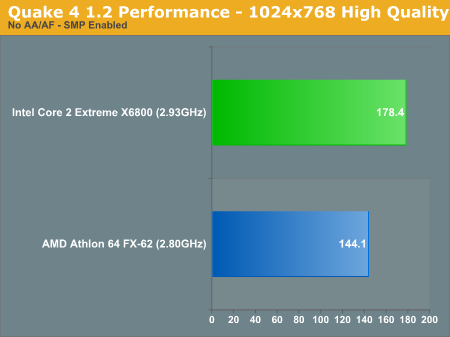
We've also already seen Conroe's performance under F.E.A.R., and with the latest 1.05 patch performance is in line with our expectations:
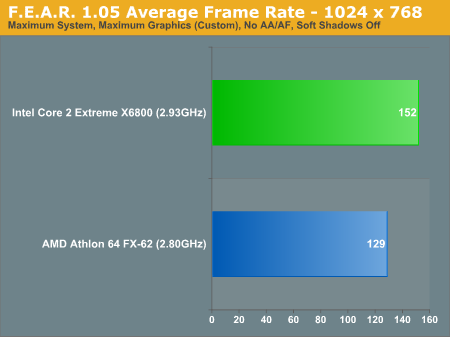
Core 2 Extreme boasts a 17.8% performance advantage over the FX-62 in average frame rate.
The minimum frame rate is significantly higher at 50.9%, and even after multiple runs the performance advantage was consistent:
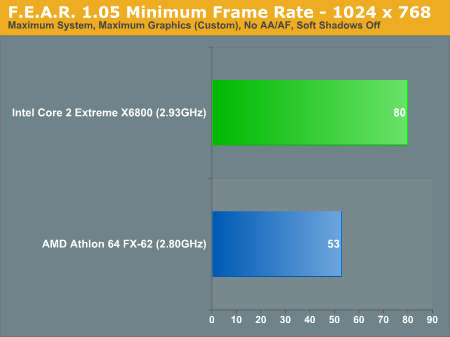
Finally the Core 2 Extreme system was able to boast a 14.2% higher maximum frame rate under F.E.A.R.
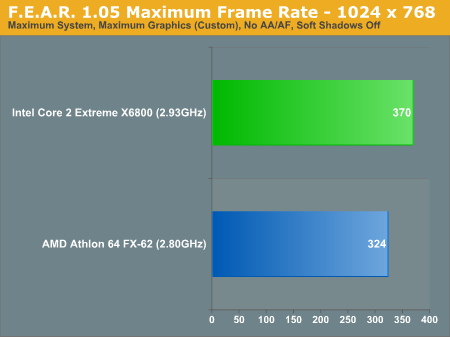
Our final gaming benchmark during our short but sweet testing period with the Core 2 Extreme was Battlefield 2, and its performance was in line with what we've seen in the previous two titles:
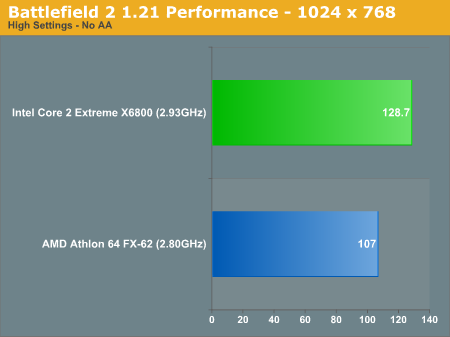
Intel's holding on to a 20.3% performance advantage under Battlefield 2.
We're still wary of crowning Intel the new gaming performance champion, especially without having run other very important titles such as Oblivion and Half Life 2: Episode 1, but until we can things are definitely looking extremely promising for the Core architecture.










134 Comments
View All Comments
jkostans - Tuesday, June 6, 2006 - link
By testing at low resolutions they are trying to reduce the impact the video card has on the benchmarks. If you make the video card the bottleneck by upping the resolution, then you aren't really benchmarking the CPUs. The whole point of the article is to benchmark the CPUs.Josh7289 - Tuesday, June 6, 2006 - link
It's because at lower resolutions, the PC is almost entirely CPU limited, not GPU limited, so it is actually easier to see how well these processors perform at lower resolutions.toyota - Tuesday, June 6, 2006 - link
well when can we see some realistic benchmarks then? the people buying the AMD FX and Intel EE cpus with a decent video card are going to play at higher resolutions and use some aa/af. i would like to see what difference that would make. yes i know that what make more load on the gpu but it is more realistic for gamers.IntelUser2000 - Tuesday, June 6, 2006 - link
That's absolute BS. Then you can get a Sempron or Celeron D and a very good video card. But we are looking how the CPU performs over VARIOUS benchmarks aren't we??
redbone75 - Tuesday, June 6, 2006 - link
Hahaha! I guess I was wrong about the naysayers on my previous review. Did you read the article and see that they were only using a single 7900GTX for each system? F.E.A.R. would bring even these systems to a crawl at 1600 x 1200. Even so, there would be no reason to believe that the FX62 would magically cover that much ground by upping the resolution and effects.By the way, there is an error in your F.E.A.R. maximum frame rate graph. Those numbers can't be right: 370 vs. 324? At those frame rates who cares which system you buy :)
AnnonymousCoward - Wednesday, June 7, 2006 - link
High max frame rates doesn't mean it was an error. Frames can spike to be super high for a split second.peternelson - Tuesday, June 6, 2006 - link
Just a quick question.....WHY do your reviews persist in using blue bars for AMD, and green bars for Intel?
Surely it would make more sense to reverse these so they reflect the chosen corporate colours of green for AMD and blue for Intel.
If there is some perverse reason why you do the opposite, please explain!
JarredWalton - Tuesday, June 6, 2006 - link
LOL - good question. No real conspiracy, though: blue is the default color, so generally we just mark the "new" items in a different color (which defaults to green). Just think of blue as "currently reviewed" and green (or other colors) as new information. :)peternelson - Wednesday, June 7, 2006 - link
Thanks for the explanation. Maybe you can try it by changing the default colours depending on what you are reviewing?As things are we're forced to actually READ the legend text and fight our brain against the psychological cues given by colours. LOL.
redbone75 - Tuesday, June 6, 2006 - link
Quite impressive, indeed. Maybe now more of the naysayers will start seeing the forest for the trees. My only problem is resisting jumping the gun once Core 2 Duo is available and wait for a little maturity for the motherboard bios'.